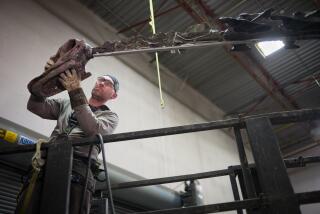What in the World Is That Old Thing? : Museums: On Identification Day, visitors haul in their treasures. Maybe an expert can figure out what they are. Or, maybe a scientist will share a few secrets.
- Share via
NEW YORK — Four-year-old Andrew Hitchings says he wants to be a crocodile. And eat tuna fish in the bathtub.
“He’s into reptiles,” says his mother, Mary Hitchings.
Linda Ford, a herpetologist--that’s someone who studies amphibians and reptiles--nods and opens the white croc jawbone one more time for Andrew. She sits behind a table resplendent with a coiled boa skeleton, snakeskins and salamanders.
Nearby, what seems to be the largest, hairiest spider in the world is taken out of a cage. It’s a tarantula, the man says. The crowd gasps.
It’s all part of Identification Day at the American Museum of Natural History--the one day of the year when the curious can shuffle up to a team of museum experts and ask them to identify old hunks of who-knows-what many people store in attics and in back-of-the-closet boxes.
A dozen or so museum scientists also put specimens from their own collections on display for visitors to examine.
Meanwhile, many of the hundreds of visitors lug in all kinds of things--strange rocks or bones from the back yard, or, from somewhere exotic, like Africa or Australia--or from Bergen County, N.J. That’s where one boy found one of the best specimens of the day: a 2,000-year-old stone spear point.
Some visitors can’t get enough.
Barbara Ward keeps coming back. This year, she had a bagful. First, a skunk head, then a seal spine, a muskrat jaw and an antelope horn.
“I keep digging them out of my closet,” said Ward, a Manhattan sales executive and self-avowed gatherer. “My grandfather used to take me on these incredible walking hikes. We’d always gather things.”
Nearby, a young woman in red lipstick and heavy jewelry stood beaming in front of the anthropology table.
“It’s cool. I love it. I love it. I love it,” says Paul Beelitz, collections manager, as he examined her fish decoy, a wooden object about half a foot long. “It’s meant to draw fish. It’s like a duck decoy,” he explains.
This is one of about a dozen Identification Days the museum has held. One year, someone hauled in the upper body mask from an African tribe. Another year, a woman pleaded with scientists to figure out what the glass-like objects were in her cat’s food.
“It turned out to be perfectly fine for the cat to eat. Perfectly normal, chopped-up parts of fish eyes,” said Corinne Lewkowicz, a museum spokeswoman.
“People come in with everything under the sun,” she said. Finds have included a 375-million-year-old fossil worm, a whale’s jaw bone dug from a garden in the Bronx and a ceremonial staff from Papua New Guinea.
Educational programs like Identification Day give herpetologist Ford and her colleagues a change of pace from office or field research duties, she said. And it gives children a chance to meet scientists.
Some surrounded technician David Brody of Entomology--that’s bug science to you and me--holding the tarantula. Brody has staffed the spider station at Identification Day for eight years.
“Kids love insects,” Brody said. “Well, they bump into insects more than adults.”
He turns back to the crowd. “She’ll tell me if she’s tired of me holding her. She’ll drop her fangs lightly.” The crowd gasps again.
By the end of the day, a few things seem to be confirmed for some of the visitors.
“I want to be a marine biologist,” said Elizabeth Anderson, 9. “I like animals. I don’t like insects. It’s not because they do weird things. They’re just not my type.”
More to Read
Sign up for The Wild
We’ll help you find the best places to hike, bike and run, as well as the perfect silent spots for meditation and yoga.
You may occasionally receive promotional content from the Los Angeles Times.






